Biology
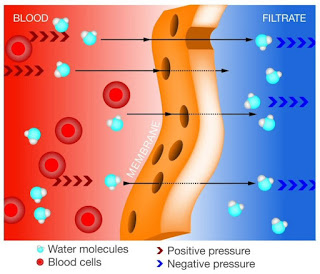 Ultrafiltration occurs at the barrier between the blood and the filtrate in the renal capsule or Bowman's capsule in the kidneys.
Ultrafiltration occurs at the barrier between the blood and the filtrate in the renal capsule or Bowman's capsule in the kidneys.
Ultrafiltration
The Bowman's capsule contains a dense capillary network called the glomerulus. Blood flows into these capillaries through the afferent arteriole and leaves through the efferent arteriole.
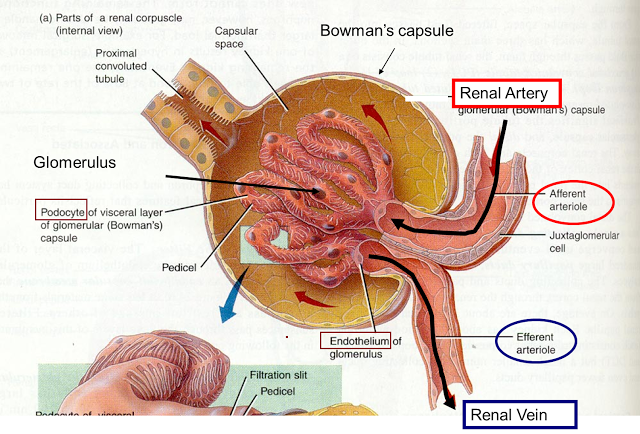
The blood in a glomerulus is separated from the space inside the renal capsule by:
? the capillary wall (endothelium) which is one cell thick and has pores in it;
? the basement membrane of the wall of the renal capsule;
? the layer of cells making up the wall of the renal capsule, called podocytes; these cells have slits between them.
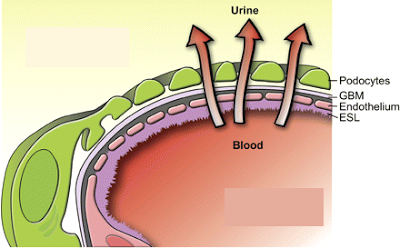
The pores in the capsulary endothelium and the slits between the podocytes will let all molecules through, but the basement membrane acts as a filter and will only let small molecules pass through.
- Substances that can pass through include water, glucose, inorganic ions such as Na+, K+ and Cl- and urea.
- Substances that cannot pass through include red and white blood cells and plasma proteins (such as albumen and fibrinogen).
- The liquid that seeps through into the renal capsule is called glomerular filtrate.
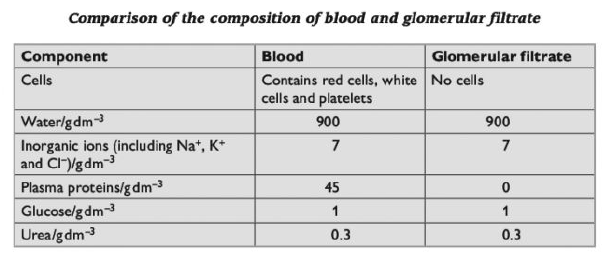
Selective reabsorption in the proximal convoluted tubule
Some of the substances that are filtered into the renal capsule need to be retained by the body. These include:
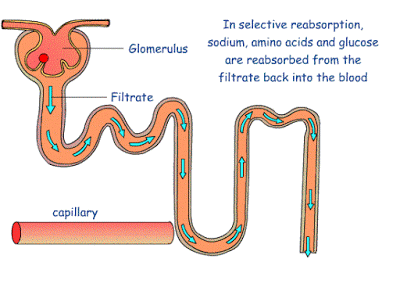
The cells in the walls of the tubule have many mitochondria, to provide ATP for active transport. Their surfaces facing the lumen of the tubule have a large surface area provided by microvilli.
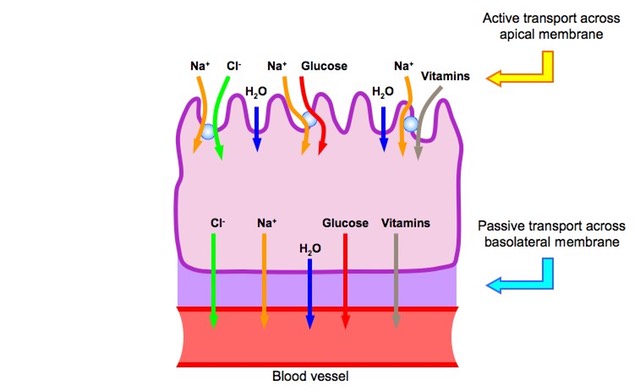
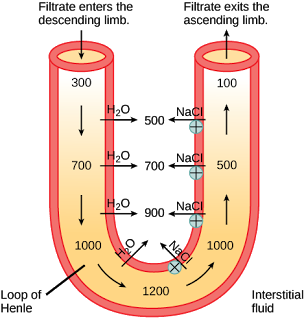
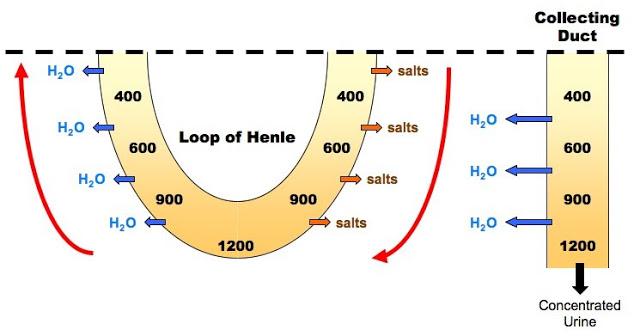
The distal convoluted tubule and collecting duct
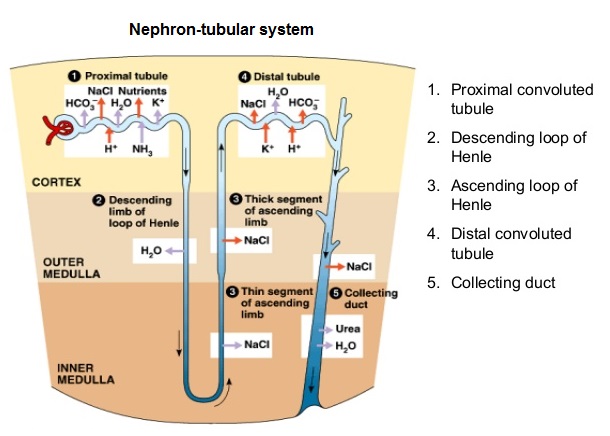
- #113 The Control Of Blood Glucose
The blood glucose concentration is regulated by negative feedback control mechanisms. Blood glucose concentration should remain at a fairly constant value of about 100 mg glucose per 100 cm3 of blood. If blood glucose concentration falls well below...
- #110 Excretion And Structure Of Kidneys
The kidneys remove wastes from the blood and are the effectors for controlling the water potential of the blood. The removal of waste products generated by metabolic reactions inside body cells is called Excretion. Some of these products are toxic,...
- #108 Homeostasis In Mammals
In the body of an animal conditions such as water concentration, temperature, and glucose concentration must be kept as constant as possible. Control systems that keep such conditions constant are examples of homeostasis; this is the maintenance of constant...
- # 107 Homeostasis Syllabus 2016
14.1 Homeostasis in mammals 14.2 Homeostasis in plants Cells function most efficiently if they are kept in near constant conditions. Cells in multicellular animals are surrounded by tissue fluid. The composition, pH...
- Excretory Products And Their Elimination
Click here for PDFExcretion is the elimination of metabolic wastes like ammonia, urea, uric acid etc. from the tissues. It is 3 types: 1. Ammonotelism: Process of excretion of NH3.Ammonotelic animals: Aquatic invertebrates, bony fishes,...
Biology
#111 Production of urine in a nephron - Ultrafiltration and reabsorption
 Ultrafiltration occurs at the barrier between the blood and the filtrate in the renal capsule or Bowman's capsule in the kidneys.
Ultrafiltration occurs at the barrier between the blood and the filtrate in the renal capsule or Bowman's capsule in the kidneys.Ultrafiltration
The Bowman's capsule contains a dense capillary network called the glomerulus. Blood flows into these capillaries through the afferent arteriole and leaves through the efferent arteriole.

The blood in a glomerulus is separated from the space inside the renal capsule by:
? the capillary wall (endothelium) which is one cell thick and has pores in it;
? the basement membrane of the wall of the renal capsule;
? the layer of cells making up the wall of the renal capsule, called podocytes; these cells have slits between them.

The blood in a glomerulus is at a relatively high pressure, because the efferent arteriole is narrower than the afferent arteriole. This forces molecules from the blood through these three structures, into the renal capsule.
- Substances that can pass through include water, glucose, inorganic ions such as Na+, K+ and Cl- and urea.
- Substances that cannot pass through include red and white blood cells and plasma proteins (such as albumen and fibrinogen).
- The liquid that seeps through into the renal capsule is called glomerular filtrate.

Selective reabsorption in the proximal convoluted tubule
Some of the substances that are filtered into the renal capsule need to be retained by the body. These include:
- much of the water
- all of the glucose
- some of the inorganic ions

- Active transport is used to move Na+ out of the outer surface of a cell in the wall of the proximal convoluted tubule, into the blood.
- This lowers the concentration of Na+ inside the cell, so that Na+ ions diffuse into the cell from the fluid inside the tubule. The Na+ ions diffuse through protein transporters in the cell surface membrane of the cell
- As the Na+ions diffuse through these transporter proteins, they carry glucose molecules with them. This is called co-transport. The glucose molecules move through the cell and diffuse into the blood.
- The movement of Na+ and glucose into the blood decreases the water potential in the blood. Water therefore moves by osmosis from the fluid inside the tubule, down a water potential gradient through the cells making up the wall of the tubule and into the blood.

Aa a result, the fluid inside the nephron now has:
- no glucose
- a lower concentration of Na+than the filtrate originally had
- less water than the filtrate originally had
About 50% of the urea is also reabsorbed in the proximal convoluted tubule.
The loop of Henle
Some, but not all, nephrons have long loops of Henle that dip down into the medulla and then back up into the cortex. The function of the loop of Henle is to build up a high concentration of Na+ and CI- in the tissues of the medulla. This allows highly concentrated urine to be produced. Note that the loop of Henle itself does not produce highly concentrated urine.
As fluid flows down the descending limb of the loop of Henle, water moves out of it by osmosis. By the time the fluid reaches the bottom of the loop, it has a much lower water potential than at the top of the loop. As it flows up the ascending limb, Na+ and Cl- move out of the fluid into the surrounding tissues, first by diffusion and then by active transport.
This creates a low water potential in the tissues of the medulla. The longer the loop, the lower the water potential that can be produced.

Role of loop of Henle
- Creating a Salt Gradient in the Medulla
- The function of the loop of Henle is to create a salt bath concentration in the fluid surrounding the tubule
- The descending limb of the loop of Henle is permeable to water, but impermeable to salts
- The ascending limb of the loop of Henle is permeable to salts, but impermeable to water
- This means that as the loop descends into the medulla, the interstitial fluid becomes more salty (and less salty as it ascends into the cortex)
- As the vasa recta blood network that surrounds the loop flows in the opposite direction (counter-current exchange), this further multiplies the effect.

The distal convoluted tubule and collecting duct
The fluid inside the tubule as it leaves the loop of Henle and moves into the collecting duct has lost a little more water and more Na+ than it had when it entered the loop. Because more water has been lost, the concentration of urea has increased.
Now, in the distal convoluted tubule, Na+ is actively transported out of the fluid.
The fluid then flows through the collecting duct. This passes through the medulla, where you have seen that a low water potential has been produced by the loop of Henle. As the fluid continues to flow through the collecting duct, water moves down the water potential gradient from the collecting duct and into the tissues of the medulla. This further increases the concentration of urea in the tubule. The fluid that finally leaves the collecting duct and flows into the ureter is urine.

VIDEO
Homeostasis in humans
Homeostasis in humans
Homeostasis in mammals requires complex systems to maintain internal conditions near constant. The kidneys remove wastes from the blood and are the effectors for controlling the water potential of the blood. a) discuss the importance of homeostasis in mammals and explain the principles of homeostasis in terms of internal and external stimuli, receptors, central control, co-ordination systems, effectors (muscles and glands) b) define the term negative feedback and explain how it is involved in homeostatic mechanisms c) outline the roles of the nervous system and endocrine system in co-ordinating homeostatic mechanisms, including thermoregulation, osmoregulation and the control of blood glucose concentration d) describe the deamination of amino acids and outline the formation of urea in the urea cycle (biochemical detail of the urea cycle is not required) e) describe the gross structure of the kidney and the detailed structure of the nephron with its associated blood vessels using photomicrographs and electron micrographs f) describe how the processes of ultrafiltration and selective reabsorption are involved with the formation of urine in the nephron g) describe the roles of the hypothalamus, posterior pituitary, ADH and collecting ducts in osmoregulation h) explain how the blood glucose concentration is regulated by negative feedback control mechanisms, with reference to insulin and glucagon i) outline the role of cyclic AMP as a second messenger with reference to the stimulation of liver cells by adrenaline and glucagon j) describe the three main stages of cell signalling in the control of blood glucose by adrenaline as follows: ? hormone-receptor interaction at the cell surface ? formation of cyclic AMP which binds to kinase proteins ? an enzyme cascade involving activation of enzymes by phosphorylation to amplify the signal k) explain the principles of operation of dip sticks containing glucose oxidase and peroxidase enzymes, and biosensors that can be used for quantitative measurements of glucose in blood and urine l) explain how urine analysis is used in diagnosis with reference to glucose, protein and ketones 14.2 Homeostasis in plants Stomatal aperture is regulated in response to the requirements for uptake of carbon dioxide for photosynthesis and conserving water. a) explain that stomata have daily rhythms of opening and closing and also respond to changes in environmental conditions to allow diffusion of carbon dioxide and regulate water loss by transpiration b) describe the structure and function of guard cells and explain the mechanism by which they open and close stomata c) describe the role of abscisic acid in the closure of stomata during times of water stress (the role of calcium ions as a second messenger should be emphasised) |
- #113 The Control Of Blood Glucose
The blood glucose concentration is regulated by negative feedback control mechanisms. Blood glucose concentration should remain at a fairly constant value of about 100 mg glucose per 100 cm3 of blood. If blood glucose concentration falls well below...
- #110 Excretion And Structure Of Kidneys
The kidneys remove wastes from the blood and are the effectors for controlling the water potential of the blood. The removal of waste products generated by metabolic reactions inside body cells is called Excretion. Some of these products are toxic,...
- #108 Homeostasis In Mammals
In the body of an animal conditions such as water concentration, temperature, and glucose concentration must be kept as constant as possible. Control systems that keep such conditions constant are examples of homeostasis; this is the maintenance of constant...
- # 107 Homeostasis Syllabus 2016
14.1 Homeostasis in mammals 14.2 Homeostasis in plants Cells function most efficiently if they are kept in near constant conditions. Cells in multicellular animals are surrounded by tissue fluid. The composition, pH...
- Excretory Products And Their Elimination
Click here for PDFExcretion is the elimination of metabolic wastes like ammonia, urea, uric acid etc. from the tissues. It is 3 types: 1. Ammonotelism: Process of excretion of NH3.Ammonotelic animals: Aquatic invertebrates, bony fishes,...
